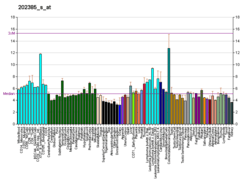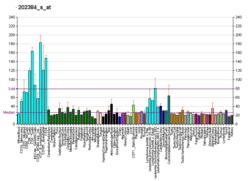Treacle protein
Treacle protein is a protein that in humans is encoded by the TCOF1 gene.[5][6]
This gene encodes a nucleolar protein with an LIS1 homology domain. The protein is involved in ribosomal DNA gene transcription through its interaction with upstream binding factor (UBF). Mutations in this gene have been associated with Treacher Collins syndrome, a disorder which includes abnormal craniofacial development. Alternate transcriptional splice variants encoding different isoforms have been found for this gene, but only three of them have been characterized to date.[6]
TCOF1 is a gene that provides instructions for making a protein called treacle.[7] This protein is active during early embryonic development in structures that become bones and other tissues in the face. Although the precise function of this protein is unknown, researchers believe that it plays a critical role in the development of facial bones and related structures.
Studies suggest that treacle is involved in the production of a molecule called ribosomal RNA (rRNA) within cells. Treacle is active in the nucleolus, which is a small region inside the nucleus where rRNA is produced. As a major component of cell structures called ribosomes, rRNA is essential for the assembly of proteins.
Aside from its interaction with UBF, treacle has been implicated in the methylation of the precursor to mature ribosomal RNA by interaction with the nucleolar protein pNop56.[8]
The TCOF1 gene is located on the long (q) arm of chromosome 5 between positions 32 and 33.1, from base pair 149,717,427 to base pair 149,760,047.
Related diseases
More than 120 mutations in the TCOF gene have been identified in people with Treacher Collins syndrome. Most of these mutations insert or delete a small number of DNA building blocks (base pairs) in the TCOF1 gene. TCOF1 mutations lead to the production of an abnormally small, nonfunctional version of treacle or prevent the cell from producing this protein. Researchers speculate that a loss of treacle reduces the production of rRNA in parts of the embryo that develop into facial bones and tissues. It is not known how loss of the treacle protein causes the specific problems with facial development found in Treacher Collins syndrome. For instance, mutations in the TCOF gene of these individuals often result in a cleft palate.[9]
Model organisms
Mutations in this gene in Jindo dogs have been associated to the observed cranial differences between Jindo and boxer dogs.[10]
References
- GRCh38: Ensembl release 89: ENSG00000070814 - Ensembl, May 2017
- GRCm38: Ensembl release 89: ENSMUSG00000024613 - Ensembl, May 2017
- "Human PubMed Reference:". National Center for Biotechnology Information, U.S. National Library of Medicine.
- "Mouse PubMed Reference:". National Center for Biotechnology Information, U.S. National Library of Medicine.
- Jabs EW, Li X, Coss CA, Taylor EW, Meyers DA, Weber JL (Feb 1992). "Mapping the Treacher Collins syndrome locus to 5q31.3----q33.3". Genomics. 11 (1): 193–8. doi:10.1016/0888-7543(91)90118-X. PMID 1765376.
- "Entrez Gene: TCOF1 Treacher Collins-Franceschetti syndrome 1".
- Valdez BC, Henning D, So RB, Dixon J, Dixon MJ (2004). "The Treacher Collins syndrome (TCOF1) gene product is involved in ribosomal DNA gene transcription by interacting with upstream binding factor". Proc. Natl. Acad. Sci. U.S.A. 101 (29): 10709–14. doi:10.1073/pnas.0402492101. PMC 489999. PMID 15249688.
- Gonzales B, Henning D, So RB, Dixon J, Dixon MJ, Valdez BC (2005). "The Treacher Collins syndrome (TCOF1) gene product is involved in pre-rRNA methylation". Hum Mol Genet. 14 (14): 2035–43. doi:10.1093/hmg/ddi208. PMID 15930015.
- Dixon MJ, Marazita ML, Beaty TH, Murray JC (2011). "Cleft lip and palate: understanding genetic and environmental influences". Nature Reviews Genetics (12): 167-178.
- Kim RN, Kim DS, Choi SH, et al. (2012). "Genome analysis of the domestic dog (korean jindo) by massively parallel sequencing". DNA Res. 19 (3): 275–88. doi:10.1093/dnares/dss011. PMC 3372376. PMID 22474061.
Further reading
- Splendore A, Silva EO, Alonso LG, et al. (2000). "High mutation detection rate in TCOF1 among Treacher Collins syndrome patients reveals clustering of mutations and 16 novel pathogenic changes". Hum. Mutat. 16 (4): 315–22. doi:10.1002/1098-1004(200010)16:4<315::AID-HUMU4>3.0.CO;2-H. PMID 11013442.
- Dixon MJ, Dixon J, Raskova D, et al. (1993). "Genetic and physical mapping of the Treacher Collins syndrome locus: refinement of the localization to chromosome 5q32-33.2". Hum. Mol. Genet. 1 (4): 249–53. doi:10.1093/hmg/1.4.249. PMID 1303194.
- Maruyama K, Sugano S (1994). "Oligo-capping: a simple method to replace the cap structure of eukaryotic mRNAs with oligoribonucleotides". Gene. 138 (1–2): 171–4. doi:10.1016/0378-1119(94)90802-8. PMID 8125298.
- Dixon MJ, Dixon J, Houseal T, et al. (1993). "Narrowing the position of the Treacher Collins syndrome locus to a small interval between three new microsatellite markers at 5q32-33.1". Am. J. Hum. Genet. 52 (5): 907–14. PMC 1682053. PMID 8488840.
- Dixon, Jill; Edwards, Sara J.; Gladwin, Amanda J.; Dixon, Michael J.; Loftus, Stacie K.; Bonner, Cynthia A.; Koprivnikar, Kathryn; Wasmuth, John J. (1996). "Positional cloning of a gene involved in the pathogenesis of Treacher Collins syndrome. The Treacher Collins Syndrome Collaborative Group". Nat. Genet. 12 (2): 130–6. doi:10.1038/ng0296-130. PMID 8563749.
- Bonaldo MF, Lennon G, Soares MB (1997). "Normalization and subtraction: two approaches to facilitate gene discovery". Genome Res. 6 (9): 791–806. doi:10.1101/gr.6.9.791. PMID 8889548.
- Edwards SJ, Gladwin AJ, Dixon MJ (1997). "The mutational spectrum in Treacher Collins syndrome reveals a predominance of mutations that create a premature-termination codon". Am. J. Hum. Genet. 60 (3): 515–24. PMC 1712503. PMID 9042910.
- Dixon J, Edwards SJ, Anderson I, et al. (1997). "Identification of the complete coding sequence and genomic organization of the Treacher Collins syndrome gene". Genome Res. 7 (3): 223–34. doi:10.1101/gr.7.3.223. PMID 9074926.
- Wise CA, Chiang LC, Paznekas WA, et al. (1997). "TCOF1 gene encodes a putative nucleolar phosphoprotein that exhibits mutations in Treacher Collins Syndrome throughout its coding region". Proc. Natl. Acad. Sci. U.S.A. 94 (7): 3110–5. doi:10.1073/pnas.94.7.3110. PMC 20330. PMID 9096354.
- Paznekas WA, Zhang N, Gridley T, Jabs EW (1997). "Mouse TCOF1 is expressed widely, has motifs conserved in nucleolar phosphoproteins, and maps to chromosome 18". Biochem. Biophys. Res. Commun. 238 (1): 1–6. doi:10.1006/bbrc.1997.7229. PMID 9299440.
- Suzuki Y, Yoshitomo-Nakagawa K, Maruyama K, et al. (1997). "Construction and characterization of a full length-enriched and a 5'-end-enriched cDNA library". Gene. 200 (1–2): 149–56. doi:10.1016/S0378-1119(97)00411-3. PMID 9373149.
- Marsh KL, Dixon J, Dixon MJ (1998). "Mutations in the Treacher Collins syndrome gene lead to mislocalization of the nucleolar protein treacle". Hum. Mol. Genet. 7 (11): 1795–800. doi:10.1093/hmg/7.11.1795. PMID 9736782.
- Winokur ST, Shiang R (1998). "The Treacher Collins syndrome (TCOF1) gene product, treacle, is targeted to the nucleolus by signals in its C-terminus". Hum. Mol. Genet. 7 (12): 1947–52. doi:10.1093/hmg/7.12.1947. PMID 9811939.
- Jones NC, Farlie PG, Minichiello J, Newgreen DF (1999). "Detection of an appropriate kinase activity in branchial arches I and II that coincides with peak expression of the Treacher Collins syndrome gene product, treacle". Hum. Mol. Genet. 8 (12): 2239–45. doi:10.1093/hmg/8.12.2239. PMID 10545604.
- Isaac C, Marsh KL, Paznekas WA, et al. (2000). "Characterization of the nucleolar gene product, treacle, in Treacher Collins syndrome". Mol. Biol. Cell. 11 (9): 3061–71. doi:10.1091/mbc.11.9.3061. PMC 14975. PMID 10982400.
- Emes RD, Ponting CP (2002). "A new sequence motif linking lissencephaly, Treacher Collins and oral-facial-digital type 1 syndromes, microtubule dynamics and cell migration". Hum. Mol. Genet. 10 (24): 2813–20. doi:10.1093/hmg/10.24.2813. PMID 11734546.
- Splendore A, Jabs EW, Passos-Bueno MR (2002). "Screening of TCOF1 in patients from different populations: confirmation of mutational hot spots and identification of a novel missense mutation that suggests an important functional domain in the protein treacle". J. Med. Genet. 39 (7): 493–5. doi:10.1136/jmg.39.7.493. PMC 1735178. PMID 12114482.
- Ohta S, Shiomi Y, Sugimoto K, et al. (2002). "A proteomics approach to identify proliferating cell nuclear antigen (PCNA)-binding proteins in human cell lysates. Identification of the human CHL12/RFCs2-5 complex as a novel PCNA-binding protein". J. Biol. Chem. 277 (43): 40362–7. doi:10.1074/jbc.M206194200. PMID 12171929.
External links
- GeneReviews/NCBI/NIH/UW entry on Treacher Collins Syndrome or Mandibulofacial Dysostosis
- GeneCard
- TCOF1+protein,+human at the US National Library of Medicine Medical Subject Headings (MeSH)
- TCOF1 human gene location in the UCSC Genome Browser.
- TCOF1 human gene details in the UCSC Genome Browser.





